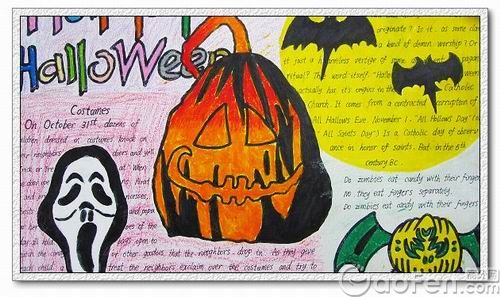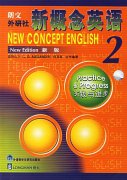万圣节英语手抄报 万圣节资料
编辑:高中作文网英语手抄报图片-万圣节

万圣节英语故事 1/3美国人迷信鬼魂
Ghosts and goblins are more than Halloween decorations or costumes for many Americans who confessed they believe in the supernatural and returning from the grave.
Thirty-seven percent of 2,100 adults questioned in a Zogby Interactive poll said they think ghosts are real, and 23 percent believe they have been visited by a deceased relative or friend.
Even the 22 percent who said they have not had any ghostly experiences themselves know someone who has.
"More than a third of Americans have this belief that ghosts do exist," said a spokesman for Zogby, adding that the findings were surprising.
Nearly half of those questioned said if they could be a ghost, they would choose to come back as themselves.
But belief in the supernatural is not required to enjoy Halloween. Eighty-seven percent of parents said their children would be dressing up for the holiday and 71 percent would be trick-or-treating.
But 41 percent of adults said they were not celebrating Halloween, including 12 percent who cited religious reasons.
Serial killers were deemed to be the scariest costumes, followed by the walking dead and zombies.
对很多美国人来说,鬼怪和妖精可不仅仅出现在万圣节的装扮或服饰上,他们坦承自己相信超自然灵异事件和鬼魂现世。
民调机构佐格比互动针对2100位成年人开展了此项调查,其中37%的受访者表示自己相信世间确有鬼魂,另有23%的受访者称已故亲友曾经回来探访。
甚至有22%没撞见过鬼的受访者也表示知道其他人有亲身体验。
佐格比互动的一位发言人说:“超过1/3的美国人相信有鬼存在。”他还表示这一发现令人大吃一惊。
近半数受访者称,如果自己也可以变作鬼,他们会选择以自己本来的样貌现身人世。
但欢度万圣节可不一定要信鬼。87%的受访家长称自己的孩子会在万圣节打扮一番,其中71%的孩子会玩儿“不请客就捣蛋”的游戏。
但41%的受访成年人表示不过万圣节,其中12%认为是出于宗教原因。
“连环杀手”被认为是最吓人的万圣节装扮,其次是活死人和僵尸。
万圣节英语故事 万圣狂欢
Halloween originated as a celebration connected with evil spirits. Witches flying on broomsticks with black cats, ghosts, goblins(小精灵) and skeletons have all evolved as symbols of Halloween. They are popular trick-or-treat costumes and decorations for greeting cards and windows. Black is one of the traditional Halloween colors, probably because Halloween festivals and traditions took place at night. In the weeks before October 31, Americans decorate windows of houses and schools with silhouettes(轮廓) of witches and black cats.
Pumpkins are also a symbol of Halloween. The pumpkin is an orange-colored squash, and orange has become the other traditional Halloween color. Carving pumpkins into jack- o'lanterns is a Halloween custom also dating back to Ireland. A legend grew up about a man named Jack who was so stingy(吝啬的) that he was not allowed into heaven when he died, because he was a miser(吝啬鬼). He couldn't enter hell either because he had played jokes on the devil. As a result, Jack had to walk the earth with his lantern until Judgement Day(审判日). The Irish people carved scary faces out of turnips(芜菁根), beets(甜菜根) or potatoes representing "Jack of the Lantern," or Jack-o'lantern. When the Irish brought their customs to the United States, they carved faces on pumpkins because in the autumn they were more plentiful than turnips. Today jack-o'-lanterns in the windows of a house on Halloween night let costumed children know that there are goodies(糖果) waiting if they knock and say "Trick or Treat!"
Halloween Treats
Dried Pumpkin Seeds
After carving your pumpkin, separate the pulp from the seeds. Rinse(冲洗) the seeds and spread them out to dry. The next day, add enough melted butter or margarine(人造黄油) to coat each seed. Spread the seeds onto a cookie sheet(甜酥饼干) and bake for 20 minutes in a 300 degree oven for 20 minutes or until they are slightly brown.
Caramel Apples
Take the paper wrapping off about 100 caramels(饴糖) and put them in a saucepan(炖锅). Put the saucepan over a pan of boiling water. Boil the water until the caramels melt. Put a wooden stick into the top of each apple, dip the apple into the caramel. Let them cool on wax paper and enjoy!
Scary Stories
No Halloween party is complete without at least one scary story. Usually one person talks in a low voice while everyone else crowds together on the floor or around a fire. The following is a retelling of a tale told in Britain and in North Carolina and Virginia.
"What Do You Come For?"
There was an old woman who lived all by herself, and she was very lonely. Sitting in the kitchen one night, she said, "Oh, I wish I had some company."
No sooner had she spoken than down the chimney tumbled two feet from which the flesh had rotted. The old woman's eyes bulged with terror.
Then two legs dropped to the hearth and attached themselves to the feet.
Then a body tumbled down, then two arms, and a man's head.
As the old woman watched, the parts came together into a great, tall man. The man danced around and around the room. Faster and faster he went. Then he stopped, and he looked into her eyes.
"What do you come for? she asked in a small voice that shivered and shook.
"What do I come for?" he said. "I come for YOU!"
The narrator shouts and jumps at the person near him!
万圣节英语故事 万圣节的神秘起源
The Origin of Halloween
万圣节的神秘起源
While there are many versions of the origins and old customs of Halloween, some remain consistentby all accounts. Different cultures view Holloween somewhat differently but traditional Halloween practices remain the same.
尽管关于万圣节的起源和旧俗有很多不同的看法,但有一些是被所有人接受的。不同文化看待万圣节总是有点不同,但是传统的万圣节做的事情都是一样的。
Halloween culture can be traced back to the Druids, a Celtic culture in Ireland, Britain and Northern Europe. Roots lay in the feastof Samhain, which was annually on October 31st to honor the dead.
万圣节文化可以追溯到德鲁伊教,这是一种爱尔兰、北欧和英国的凯尔特文化,根植于Samhain节的庆祝活动,Samhain节于每年的10月31日纪念逝者。
Samhain signifies "summers end" or November. Samhain was a harvest festival with huge sacred bonfires, marking the end of the Celtic year and beginning of a new one. Many of the practices involved in this celebration were fed on superstition.
Samhain节说明夏天结束或者十一月,是一个丰收的节日。在Samhain节会燃起神圣巨大的篝火,标志着凯尔特一年的结束和新一年的开始。一些做法因为迷信被加入庆祝活动中。
The Celts believed the souls of the dead roamed the streets and villages at night. Since not all spirits were thought to be friendly, gifts and treats were left out to pacifythe evil and ensure next years crops would be plentiful. This custom evolved into trick-or-treating.
凯尔特人相信死者的灵魂会在夜里出没在街道和村庄。因为他们认为不是所有的灵魂都是友善的,所以就把礼物和好吃的留在外面安慰恶灵来确保来年的庄稼可以丰收。这种习俗演变成了trick-or-treating。
万圣节又叫诸圣节,在每年的11月1日,是西方的传统节日。
万圣节源自古代凯尔特民族(Celtic)的新年节庆,此时也是祭祀亡魂的时刻,在避免恶灵干扰的同时,也以食物祭拜祖灵及善灵以祈平安渡过严冬。前一天晚上(也就是万圣节前夜),小孩们会穿上化妆服,戴上面具,挨家挨户收集糖果。
名称由来
万圣节是西方国家的传统节日。这一夜是一年中最“闹鬼”的一夜,所以也叫“鬼节”。华语地区常将万圣夜误称为万圣节。“Hallow”来源于中古英语halwen,与holy词源很接近,在苏格兰和加拿大的某些区域,万圣节仍然被称为“All Hallow Mas”,意思是在纪念所有的圣人(Hallow)那一天,要举行的弥撒仪式(Mass)。
关于万圣节由来的,版本繁多,流传较广的是:
两千多年前,欧洲的基督教会把11月1日定为“天下圣徒之日” (ALL HALLOWSDAY) 。“HALLOW” 即圣徒之意。传说自公元前五百年,居住在爱尔兰、苏格兰等地的凯尔特人 (CELTS) 把这节日往前移了一天,即10月31日。他们认为该日是夏天正式结束的日子,也就是新年伊始,严酷的冬季开始的一天。那时人们相信, 故人的亡魂会在这一天回到故居地在活人身上找寻生灵,借此再生,而且这是人在死后能获得再生的唯一希望。而活着的人则惧怕死魂来夺生,于是人们就在这一天熄掉炉火、烛光,让死魂无法找寻活人,又把自己打扮成妖魔鬼怪把死人之魂灵吓走。之后,他们又会把火种烛光重新燃起,开始新的一年的生活。
服装由来
万圣节的服装起源于恶作剧,大人带孩子一起出门(一般是大人驾车停在路边,小孩说:“不给糖,就捣蛋(trick or treat)。大人事先要求孩子只许去门口有节日布置的并点了灯的人家,否则不许打扰。另外讨糖过程中必须始终站在大门口等待,不许进屋,讨回的糖也要交给大人检查后才许吃。对接待孩子的人家也要求不给自家制作的食品,也不给未包装的食品。
万圣节玩具
万圣节的服装,万人万相,不只是单调的大鬼小鬼。制作最简单的鬼服就用一张白床单顶在头上,抠两个洞留出眼睛;若要扮演魔术师,就穿上黑衣黑裤,再戴上黑礼帽,并在礼帽与头顶之间藏一只绒毛小兔备用;小孩穿上白衣白裤,再在背后绑一个手电筒在头上就打扮成了小天使;也有家长把孩子打扮成他们喜欢的卡通形象的

南瓜灯由来
南瓜灯
南瓜灯源于古代爱尔兰。传说一个名叫JACK的人,是个醉汉且爱恶作剧。一天JACK把恶魔骗上了树,随即在树桩上刻了个十字,恐吓恶魔令他不敢下来,然后JACK就与恶魔约法三章,让恶魔答应施法让JACK永远不会犯罪为条件让他下树。JACK死后,其灵魂却既不能上天堂又不能下地狱,于是他的亡灵只好靠一根小蜡烛照着指引他在天地之间倘佯。
在古老的爱尔兰传说里,这根小蜡烛是在一根挖空的萝卜里放着,称作“JACK LANTERNS”,而古老的萝卜灯演变到今天,则是南瓜做的Jack-O-Lantern了。据说爱尔兰人到了美国不久,即发现南瓜不论从来源和雕刻来说都比萝卜胜一筹,于是南瓜就成了万圣节的宠物。
节日风俗
万圣节前一天夜里是一年中最“闹鬼”的时候,各种妖魔鬼怪、海盗、外星来客和巫婆们纷纷出动。在基督纪元以前,凯尔特人在夏末举行仪式感激上苍和太阳的恩惠。当时的占卜者点燃并施巫术以驱赶据说在四周游荡的妖魔鬼怪。后来罗马人用果仁和苹果来庆祝的丰收节与凯尔特人的10月31日融合了。在中世纪,人们穿上动物造型的服饰、戴上可怕的面具是想在万圣节前夜驱赶黑夜中的鬼怪。尽管后来基督教代替了凯尔特和罗马的宗教活动,早期的习俗还是保留下来了。孩子们带着开玩笑的心理穿戴上各种服饰和面具参加万圣夜舞会,这些舞会四周的墙上往往悬挂着用纸糊的巫婆、黑猫、鬼怪和尸骨,窗前和门口则吊着龇牙咧嘴或是面目可憎的南瓜灯笼。
不给糖就捣蛋
万圣节前夕,孩子们会提着南瓜灯,穿着各式各样的稀奇古怪的服装,挨家挨户地去索要糖果,不停地说:“trick or treat."(意思是给不给,不给就捣蛋)要是你不肯给糖果的话,孩子们就会很生气,用各种方法去惩罚你,例如:把垃圾倒在你家里等等的方法去惩罚你,直到你肯给他们糖果为止。
自17世纪起,庆祝万圣节的传统在南部英格兰逐渐消失,代之以在11月5日举行的火药阴谋(Gunpowder Plot)纪念会。但在苏格兰,爱尔兰和北部英格兰万圣节依然盛行。直到21世纪初,南部英格兰人才重新开始庆祝万圣节,只是方式完全美国化了。
万圣节前夜最流行的游戏是“咬苹果”。游戏时,人们让苹果漂浮在装满水的盆里,然后让孩子们在不用手的条件下用嘴去咬苹果,谁先咬到,谁就是优胜者。
万圣节源
万圣节面具
自古代凯尔特民族(Celtic)的新年节庆,此时也是祭祀亡魂的时刻,在避免恶灵干扰的同时,也以食物祭拜祖灵及善灵以祈平安渡过严冬。当晚小孩会穿上化妆服,戴上面具,挨家挨户收集糖果。

节日活动
万圣节僵尸
纽约市也特别在万圣节晚上举行巡游,让一群吸血鬼,僵尸(zombie),女巫,科学怪人等齐齐现身,还欢迎市民到场参观,到会者不限年龄、性别,不分阶级、国籍,即使你是胆小鬼,也可加入他们的行列,来个热热闹闹的人鬼嘉年华会。
其实这些鬼怪都是人扮的,所以并不可怕,相反有些小鬼脸更非常可爱,令人置身其中,就如参加大型化装舞会一样。
在各式各样的装扮角色中,以女巫僵尸一族最多人扮演,而那些专卖万圣节用品的店铺也特别准备这类衣饰出售,以迎合大众所需;与此同时,生产商每年更会把当年大热的人物造型包括面具及衣物推出市场,务求令更多人投入这西方传统节日的热潮里,如在电影<哈利波特>的小巫师造型,已是许多孩子必选的扮演角色。
格林威治村的万圣节巡游﹝Greenwich Village Halloween Parade﹞始于1973年,由一位面具工匠兼木偶演员Mr Ralph Lee发起,据说最初他带着朋友和孩童一起在邻居处游行,后来渐渐演变成整个村的大型活动,而活动中当然少不了大型木偶表演,同时,巡行的目的更希望每一个人都是参与者而不是旁观者,所以即使人们只是抱着想看热闹的心态,当你踏进村子里,很快便会被邀请参与巡行,成为他们的一份子。
纽约市的万圣节巡游每年都吸引成千上万的纽约人和游客参加,而巡游会在格林威治村﹝Greenwich Village﹞举行,各队伍约在夜晚上七时从第六大道与春天街交界﹝6th Avenue & Spring Street﹞起步,一直游行至第二十三街﹝6th Avenue & 23rd Street﹞为止,全程大概多个小时。
无论是来自亚洲,南美,非洲,欧洲,以至中东地区的参观者,都可以把自己装扮成各式各样的人物,亦可带备简单乐器,即时演奏本土的独特音乐,融合无疆界的风土文化。可能我以前从未参加过万圣节的活动,更莫说这么精彩的巡游,所以特别觉得有新鲜感。
南瓜糕饼
早于十月中,曼哈顿市已开始“闹鬼”了,在繁忙的街道上,已看见四处悬挂起万圣节的鬼怪装饰,很多百货公司也忙着把应节礼品及衣物堆放在橱窗里,吸引不少途人驻足观看,而超级市场及街市亦摆放大大小小的南瓜售卖,供市民买回家布置家园或制作南瓜灯之用,当然嘛,也有主妇烹煮南瓜作菜肴或糕饼,完全依足节庆传统
节日诗歌
思念的盒子里盛满糖果
有多少记忆是甜蜜的
有多少记忆是苦涩的
在平淡生活里
我们常常把痛苦埋得很深
在过去的记忆里
我们只把快乐的留给了今天
我们每个人
在思念的盒子里盛满了糖果
品尝一个个
昨天故事中的酸与甜
甜蜜盒子
打开甜蜜盒子
里面有思念做的糖果
品尝一颗颗甜蜜
像昨天一场场记忆
含在口中的糖
甜蜜到有点微微的心痛
捧在手中的昨天
快乐到有些深深的苦涩
秋天巧克力
爱上巧克力的时候
秋天像
咖啡色的语言
冷风果然
在落叶中旋转
夜穿上深色的衣服
纽扣一样的星星
整齐的亮在天边
手中的巧克力
黑过夜
一颗颗的细嘬
慢慢的习惯了
优雅的苦涩
丢失的记忆
看到你像糖果,
没有打开时就那么的甜蜜
在目光相遇的刹那
感觉如此的熟悉
我在
心灵的深处
翻开过往的思绪
原来你是一个
早就丢失的记忆
手心里棉花糖
把手心里棉花糖
举向天空
这朵甜蜜的白云
像个还没有醒的好梦
原来星期六上午
有个更蔚蓝的心情








